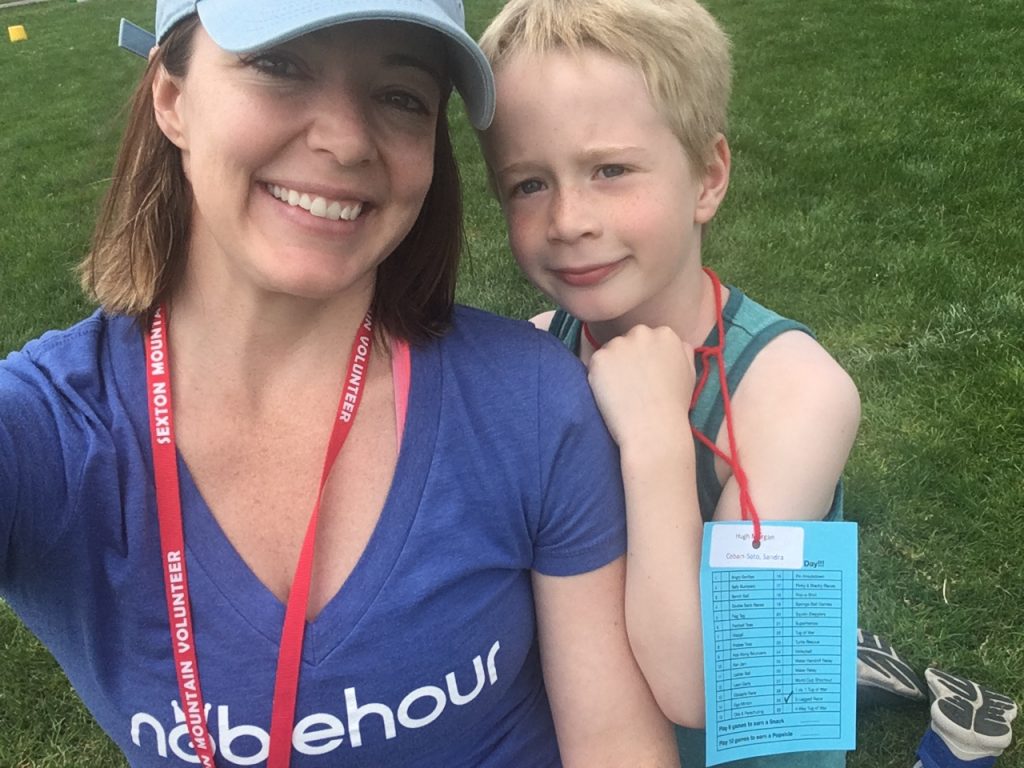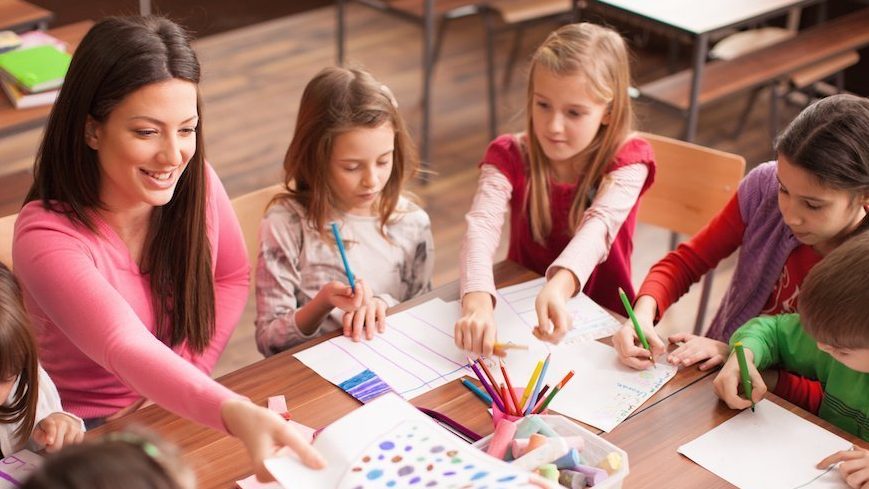During the school year, a few times a month I volunteer at my kids’ school in a program called Art Literacy. Art Literacy, which teaches and engages kids in the arts, is a staple in my kids’ school district in Beaverton, Oregon. Started by a mother of local students, the Art Literacy program offers the only elementary art program in the Beaverton School District. The craziest part? It’s 100% run by volunteers and two part-time district employees.
ABOUT ART LITERACY
The Art Literacy concept is simple: parent volunteers bring an “artist box” to a specific class once a month — 6 times a school year. In about an hour, the parent uses all the materials in that box to teach kids about the artist, the artist’s method, and themes or concepts that the artists made famous (think of Van Gogh’s impressionist style).
The students learn all about the life of an artist or the artistic expressions of a culture, and about the different creative outlets of these artists and people. Of course, there’s a Q&A session, and the younger age groups are always oh-so-curious about the artists’ lives. After that, the kids are provided the materials they need to make their own art project reflective of the style or theme of that month’s artist.
Melody Ball, the Resource Coordinator for the Art Literacy Program in the Beaverton District, broke down how the program works:
As of 2019, there are 119 different subject matters (artists or cultures) in “circulation” throughout the program. The different artists and cultures are presented by 1500 volunteers, across 36 elementaries and 11 middle schools district-wide. As of the 2019-2020 school year, Art Literacy is present in every elementary and middle school in the district. It’s also their 40th year in operation in Beaverton School District — a huge accomplishment!
Each school has a “core” of volunteers who coordinate the program at their specific school (there are about 100 of these core volunteers across the district). These parents, like Crystal Wilson, help coordinate between teachers’ and volunteers’ schedules, make sure the right boxes arrive at the right school, and that schools with fewer volunteers get the help and support they need. They also teach the parent volunteers about the artist or culture they will be presenting that month). The parent volunteers then teach the materials in each classroom at their school.
Because of the commitment of these dedicated volunteers, as well as the wider circle of our parent volunteers (myself included), this amazing program has provided Art Literacy lessons to kids who otherwise wouldn’t have it at all.
ABOUT THE PARENT VOLUNTEERS
Together with a few dozen other parents, I volunteer each month in this program to make sure my kiddos and their classmates’ get to learn more about various artists. But through my work within the program, I’ve connected with some really amazing parents who are helping keep Art Literacy alive.
For instance, Crystal has been an active part of the program for 10 years. Even now that her kids have aged out of their classes at the elementary school, she is still part of the program and frequently volunteers at the local middle school. She plays an important role within the program by connecting with volunteers from previous years to see who will “re-up,” and then work to fill in any gaps between classes or schools.
Another parent, Andy Ridgway, has volunteered for the last four years in his kids’ school. In most cases, he says, there are two parent volunteers in each class — one to teach the material and the other keeps an eye on the kids and helps when needed. But he says the kids don’t need as much direction or wrangling as you might think.
Even kindergarteners get really interested in artists and their stories. Once they hear about the artist, they’re ready to get their hands on a project based on what they just learned.
Barb Renker, another volunteer who works alongside me in the program, is also an active member of our Parent Teach Club (PTC). Barb and the PTC help fund all of the materials needed to keep the artist boxes flush with creative project pieces. She also helps our group of volunteers ensure every class in the school is covered. As she says, there are 560 kids in the school and, if they see other kids with these art projects but they don’t get to do it, they’re going to feel like they’re missing out.
THE BEST PART ABOUT ART LITERACY — FROM THE PARENTS’ POV
One of my favorite parts of this process is watching my kids, Hugh and Henry. When they walk into the classroom and see me standing there, ready to help teach their class for an hour, you can see what a difference it makes in their lives. They always offer to help clean up at the end of class, or call me over to them to look at their creations. You can see they are proud I am there.
Crystal says: “It’s a great way to bond with your child. I’ve never seen so many excited kids when they know their parents are coming to school.” Andy shared that his favorite part was seeing how much kids engage with and benefit from these classes: “These kids really lock in. They like to listen. They’re delighted when they pull off the things that they learn about. It shows in their attitudes, it shows in their faces. You can see the wheels turning. It’s so satisfying.”
And my friend Barb adds: “My kids light up, they’re so excited to see me there.”
A CALL TO ARMS FOR OTHER PARENTS — AND THEIR EMPLOYERS
If there’s one thing I want you to take away from all of this, it’s that the Art Literacy Program would not exist without parent volunteers. And without the sheer number of volunteers, many of the schools in our district wouldn’t have access to this program.
I realize there’s not an Art Literacy program in every school district, so what does this have to do with you? Well, I think there’s an opportunity in each school and each district for parents to volunteer. As Barb so eloquently put it:
Every adult matters. You can make an impact on these students. It’s your future, it’s your kids, it’s your community that needs that help.
More and more schools are facing budget cuts all the time, and teachers are stuck picking up the extra load so their students don’t go without. Volunteering at your kids’ school could look as simple as asking teachers how you can help, or asking the school secretaries or front desk if there are programs or efforts that need parent-power.
For a lot of working parents, or parents of multiple kids, this can feel like a big ask. But there are tons of ways to support your kids’ school that doesn’t require a lengthy time commitment.
As a single, working mom, it’s difficult for me to commit to more than those few hours a month. I’m very fortunate to work for an incredibly flexible company, one that offers volunteer time off, and encourages us to take it.
For me, volunteering means moving meetings around so I can volunteer, but the impact it makes on my kids and their classmates is immeasurable.

For me, volunteering means moving meetings around so I can volunteer, but the impact it makes on my kids and their classmates is immeasurable.
What could you do to work around your work or childcare schedule? Or could you possibly help support your school in other ways, like hosting a fundraiser at work, or asking your boss for Dollars for Doing?
This is also a call to the employers out there who have maybe just started offering Volunteer Time Off, or who have corporate volunteer programs: don’t put strict rules on where your employees can volunteer, or where they spend those VTO hours. Because when you allow employees to give back to their community, to their schools, to their kids, they come back more motivated and happy to work for a company that supports those efforts.
Crystal said it better than I can:
If you let parents volunteer at their kids’ school, it gives your business a good name. People are going to want to work there because you give that flex time and a lot of parents DO want to volunteer. If they hear of a company that encourages it, that’s a perk some parents are looking for. Word gets around.
Volunteering in your local school is one of the easiest ways I know of to make an impact on the kids, on the school, on the teachers, and on yourself. So… next time you go pick the kids up, why not pop in and ask if there’s any way you can help?
And if your school (or your business) needs help organizing your volunteers and tracking their time, check out NobleHour.
Since 2007, NobleHour has proven to be the volunteer management solution for organizations across the nation. Our plug ‘n play software connects companies, schools and individuals with nonprofits. Volunteer, measure the good you’re doing, and share it with others. It’s that simple.
With offices in Lakeland, FL, and Portland, OR, the we are dedicated to empowering good in communities across the country.
By NobleHour Staff:

Allison Hale
Director of Marketing
TreeTop Commons
Portland, Oregon
Allison is the Director of Marketing for TreeTop Commons, and its products; NobleHour and Collaboratory. A Portland native, Allison volunteers regularly for community nonprofits that support sustainability programs, and at her childrens’ school teaching art literacy. |
